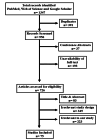Labour Pain: A Comprehensive Review of Perceptions, Experiences, and Sociocultural Influences on Pain and Its Management Practices
- PMID: 40698239
- PMCID: PMC12282679
- DOI: 10.7759/cureus.86540
Labour Pain: A Comprehensive Review of Perceptions, Experiences, and Sociocultural Influences on Pain and Its Management Practices
Abstract
Childbirth is a deeply personal and subjective experience for women, shaped by individual expectations and sociocultural perceptions. Many women approach labour with specific mental imagery and expectations regarding pain and the birthing process. However, these expectations often differ from the actual experience, which can result in emotional distress during and after childbirth. This scoping review systematically searched PubMed, Scopus, and Web of Science databases to identify studies published between 1984 and 2024 focusing on labour pain perception and experience. Only peer-reviewed articles in English were considered. This review identified three major themes that highlighted labour pain, pain management, and the sociocultural factors that were associated with it. It has revealed that the experience of women was consistent with what they had perceived about pain, while it was inconsistent in terms of perception of pain relief during labour. However, the sociocultural paradigm did hold its place in meddling between the perceptions and experiences of these women during labour pain and management. The exploration of personal attributes and sociocultural dynamics that shaped the women's ascription of meanings to labour pain add context to how a similar physiological experience can be perceived and experienced differently.
Keywords: experience; labour pain; pain management; perceptions; sociocultural factors.
Copyright © 2025, Tandon et al.
Conflict of interest statement
Conflicts of interest: In compliance with the ICMJE uniform disclosure form, all authors declare the following: Payment/services info: All authors have declared that no financial support was received from any organization for the submitted work. Financial relationships: All authors have declared that they have no financial relationships at present or within the previous three years with any organizations that might have an interest in the submitted work. Other relationships: All authors have declared that there are no other relationships or activities that could appear to have influenced the submitted work.
Figures
Similar articles
-
Pain management for women in labour: an overview of systematic reviews.Cochrane Database Syst Rev. 2012 Mar 14;2012(3):CD009234. doi: 10.1002/14651858.CD009234.pub2. Cochrane Database Syst Rev. 2012. PMID: 22419342 Free PMC article.
-
Hypnosis for pain management during labour and childbirth.Cochrane Database Syst Rev. 2016 May 19;2016(5):CD009356. doi: 10.1002/14651858.CD009356.pub3. Cochrane Database Syst Rev. 2016. PMID: 27192949 Free PMC article.
-
More in hope than expectation: a systematic review of women's expectations and experience of pain relief in labour.BMC Med. 2008 Mar 14;6:7. doi: 10.1186/1741-7015-6-7. BMC Med. 2008. PMID: 18366632 Free PMC article.
-
Women's experience of menopause: a systematic review of qualitative evidence.JBI Database System Rev Implement Rep. 2015 Sep 16;13(8):250-337. doi: 10.11124/jbisrir-2015-1948. JBI Database System Rev Implement Rep. 2015. PMID: 26455946
-
Sexual Harassment and Prevention Training.2024 Mar 29. In: StatPearls [Internet]. Treasure Island (FL): StatPearls Publishing; 2025 Jan–. 2024 Mar 29. In: StatPearls [Internet]. Treasure Island (FL): StatPearls Publishing; 2025 Jan–. PMID: 36508513 Free Books & Documents.
References
-
- Correlation between subjective labour pain and uterine contractions: a clinical study. Corli O, Grossi E, Roma G, Battagliarin G. Pain. 1986;26:53–60. - PubMed
-
- The nature of labour pain. Lowe N. Am J Obstet Gynecol. 2002;186:0. - PubMed
-
- Women's experience of pain during childbirth. Lundgren I, Dahlberg K. Midwifery. 1998;14:105–110. - PubMed
-
- Severity of labour pain: influence of physical as well as psychologic variables. Melzack R, Kinch R, Dobkin P, Lebrun M, Taenzer P. https://pmc.ncbi.nlm.nih.gov/articles/PMC1875749/?page=1. Can Med Assoc J. 1984;130:579–584. - PMC - PubMed
-
- Analgesia in labour and fetal acid-base balance: a meta-analysis comparing epidural with systemic opioid analgesia. Reynolds F, Sharma SK, Seed PT. BJOG. 2002;1:1344–1353. - PubMed
Publication types
LinkOut - more resources
Full Text Sources

